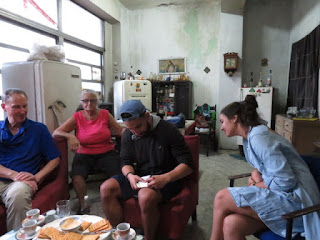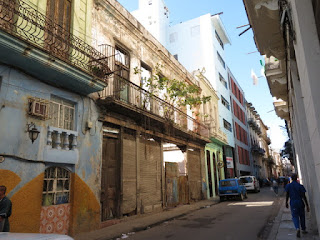I mentioned earlier that we had planned to fix some of our
own food, but were warned by our hostess that it can be very hard to find the
food you want to eat. It is easy to find your basic fruits and vegetables
at markets scattered around town. Meat
can be a little harder. All cows are
owned by the government and there seem not to be enough of them to provide
meat. Ropa vieja, traditionally beef, is
increasingly being made from lamb for instance.
Ropa vieja is slow cooked, shredded meat. Farmers still look after the cows, but if a
cow dies on your farm, there is a significant investigation into cause of death
and a big fine or even jail if you are found liable in the cow’s death. We were told by several people that you get
off easier killing a person than killing a cow.
Pork can be grown privately and seemed relatively available, but you
have to know where you’re buying it from in terms of how sanitary it is. Chickens are sold in separate stores. Eggs were in short supply while we were
there, although one day we saw lots of people carrying a flat of 2 dozen eggs
away from a house down the street and our hostess had purchased 30 eggs in
anticipation of our arrival. Some of the
“supermercados” had rice, beans and sugar for sale in big sacks but little
else. I mean we’re talking a big store
with a few bottles of vinegar and a couple cans on the shelves and then these
big sacks that would feed two people for several months. There was one small store in the neighborhood
that always had a line of people and it looked like you might be able to buy
some dried pasta, soap, and cooking oil there.
Maria fixed us breakfast every morning. Café con leche or tea. Always a plate of
fresh fruit (pineapple, bananas and papaya (called bomba in Cuba because “papaya”
is a salacious slang word) and either guava or pineapple juice. Usually a sweet bread or pastry. Eggs scrambled or fried, cheese slices,
sometimes some ham, and whole wheat rolls or French bread slices with butter
and jam. We got tired of eggs after a
few days and skipped them for a couple mornings. On our
last night Yanelis and Maria fixed dinner for us. They made bruschetta with tomato and arugula,
chicken barbacoa slow cooked in soy sauce and beer, boiled potatos, and pasta
with a tomato tuna sauce. Maria’s
husband Eric went out to get a bottle of Cuban made red wine. With ice it wasn’t too bad. Speaking of ice, not even most Cubans drink
the tap water. Most of them boil and
then filter the water or buy bottled water.
At the restaurants that tourists are likely to eat at they all seem to
make ice from bottled or filtered water.
We usually bought bottled water at restaurants or stores that seemed to
sell a lot of beverages because some street vendors have been known to refill
water bottles and make them look sealed.
We did sometimes buy sodas in cans from street vendors though. Each room at the house had a small
refrigerator stocked with bottles of water and soda.
Two doors down from our house was a great “paladar”, private
restaurant, called Grados (Calle E between 23 and 25). You could sit on the porch screened from the
street by tropical potted plants or just indoors. They make their own focaccia and somehow
smoke it to lend a different flavor. We
ate there twice. They had a great lamb
dish slow cooked in a sauce made from Puye, a sort of herbal drink made in
another region of Cuba. Jake had pork
both times cooked in different ways but always tender and flavorful. I had a small swordfish steak another night
served with yucca and a delicately flavored white sauce. Jake had their take on Callaloo, a Caribbean
soup. It had some greens wrapped around
goat cheese over which they poured a light broth. Another appetizer featured a polenta-like
base with greens and tiny poached eggs. And
they make a great mojito!

The Farm to Table tour took us from the Mediterraneo Havana
restaurant (Calle 13 between F and G) to
the Rancho Vista Hermosa in Guanabacoa, about a 25 minute drive east of
Havana. Mediterraneo may be the only
farm to table restaurant in Havana or was at least the first. The farm grows
all kinds of things and raises all kinds of animals. They now also have a facility to make cheese
and process meat and a restaurant on site for groups. Private farms can only have a maximum acreage
of 165 acres. This one reminded me of what
I’ve read about Polyface farm in VA. Pigs,
chickens, geese and guinea hens ranged around the farm and ate weeds from under
the mango, guava, banana and other fruit trees.
Rabbits lived in pens raised over a dirt floor where guinea pigs cleaned
up after them (they do not eat the guinea pigs). The farm makes a fodder out of a mix of white
mulberry, sugar cane stalks, sweet potato vines, and king grass (a species of
Pennisetum?). It has a big shade house
for growing greens and herbs. German
shepherds guard the animals at night – mostly from poachers and people
practicing Santeria apparently. They
grow 17 varieties of sugar cane for different purposes. Tilapia and some other fish grow in a spring
fed pond and blue-clawed crayfish are grown in cement tanks.
 |
| Hauling sugar cane stalks |
 |
| Guava, pineapple and sugar cane |
 |
| Livestock guard dog, hopefully more alert at night |
 |
| Food scraps to feed pigs and chickens |
 |
| The rabbit area with guinea pig cleanup crew |
 |
| A field of greens for fodder, white mulberry shown here |
 |
| Vegetables in the shade tent |
 |
| orchid |
 |
| horseback ride to an overlook on the farm |
 |
| Cows in the road |
 |
| Looking back over the farm |
 |
| Cows with their egrets |
 |
| Making sugar cane juice |
Our guide Kensys led us around the farm and introduced us to
some of the 25 people who work there. He
also joined us for lunch back at the restaurant in Havana. We ate on the second
floor terrace as the downstairs was occupied by a tour group, but the terrace
is really pleasant. We started by
sampling three of the cheeses and the cured ham and sausage made at the farm
(and a mojito for me and Kensys). This
was followed by ravioli stuffed with the farm’s goat’s milk mozzarella served
with a tomato sauce made from fresh tomatos.
The main course was a grilled skewer of pork, chicken, bacon and pork
sausage with peppers and onions. Dessert
was homemade vanilla ice cream served with the farm’s honey. The chef is Italian and invested in the cheese
production aspect of the farm.
The third paladar we ate at in Vedado is Idilio (Calle 15,
corner of Av. Presidente). They serve a
lot of seafood dishes. We ordered an
appetizer of piquillo peppers stuffed with tuna or salmon. I also got a cocktail made with aguardiente
and honey that Yanelis had recommended, very drinkable. The peppers seemed like
they were probably out of a jar rather than fresh and stuffing has a little too
much like tuna with mayo, but the salmon stuffing was better with some dried
fruit added in. The main courses were
quite good. Jake got grilled mixed
seafood that included a spiny lobster tail, a piece of swordfish and some small
shrimp. I ordered the mariscos enchilada
which was shrimp and lobster pieces in a tasty tomato based sauce. These came with arroz morro (rice mixed with
black beans) and I got a side dish of fried plantains that turned out to be very
thin slices cooked to be crispy. The
restaurant’s tables are under a covered patio with pretty blue-checked
tablecloths.
Other places we ate were somewhat hit or miss, but a few to
recommend:
Topoly – an Iranian restaurant on the corner of 23rd
and Calle D. We took a couple afternoon
breaks on their pleasant porch screened from the street by a bubbling fountain
and plants. They had an interesting tea
frappe, good coffee, baba ganoush, or desserts like flan and cake roll for
something sweet.
 |
| A snack at Topoly |
Café Cuatro Lunas -
Calle I between 23 and 25. The most
beautifully decorated daiquiri with a rose petal on top and a curled lime rind
garnish. Inexpensive typical Cuban
food. Really friendly servers and a
pretty room with big windows. They also
serve breakfast.
MekedÉ – Old Havana near the Museum of the Revolution, Monseratte
211. Good place for a drink or
lunch. We just got bruschetta and
lemonade there but they were really good.
Esto no es un Café – Callejon del Chorro off of Plaza de la
Catedral, Old Havana. This little alley
is known for its selction of Paladars and this one just seemed a good spot to
us. We shared a bowl of ratatouille and
roast chicken with vegetables. Good for
big servings of cooked vegetables!
 |
| Record placemats at Mekede |
La Fortuna – in Playa on First Avenue. Quirky décor inside (you can sit in a VW bug
or on a buggy or lie in a bathtub) and a small deck with a view of the Ocean. An enormous chicken, gouda and olive sub for
5 CUC. Cute male servers wearing sailor’s
outfits.
 |
| The view from La Fortuna |














































